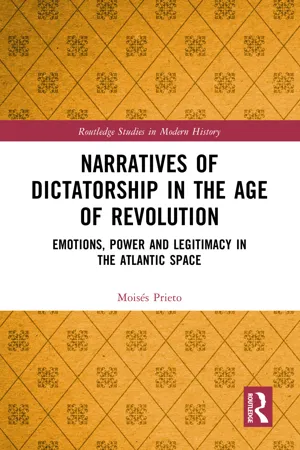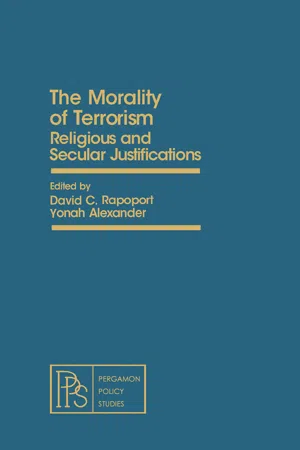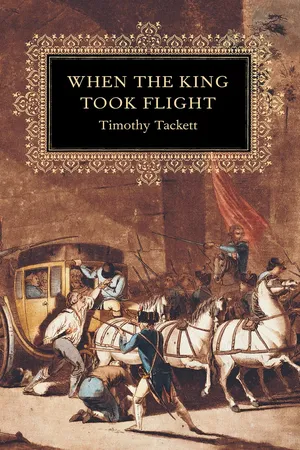History
The Great Fear
The Great Fear refers to a period of panic and unrest during the early stages of the French Revolution in 1789. It was characterized by widespread fear and paranoia among the rural population, leading to mass hysteria and violent actions such as the destruction of feudal documents and properties. The Great Fear ultimately contributed to the collapse of the old regime and the rise of revolutionary fervor.
Written by Perlego with AI-assistance
Related key terms
1 of 5
3 Key excerpts on "The Great Fear"
- eBook - ePub
Narratives of Dictatorship in the Age of Revolution
Emotions, Power and Legitimacy in the Atlantic Space
- Moisés Prieto(Author)
- 2022(Publication Date)
- Routledge(Publisher)
60Similar fear phenomena, but with considerable differences due to its particular context are claimed by Manuel Chust and Claudia Rosas Lauro for the Spanish American revolutions. Hence, for instance, the fears of slaves seizing power as this had happened in Saint-Domingue (Haiti) in the 1790s show that the perception of the Caribbean revolution was stronger than the Parisian one. Not only fears of mutinies, rebellions, conspirations and disorder but also fears of alterity were present in a world region seeking freedom from the Spanish Crown, yet after having reached it, the Creole elites longed for the past colonial order.61 Despite the insistence to focus on and search a sort of Latin American genuineness beyond a Eurocentric view, another parallel may be seen in Bolívar’s guerra a muerte (Engl. “war to the death”) as a radicalization of the bellicose efforts again the Spaniards in 1813 uttered as a decree allowing atrocities against those who were born in Spain, thus opening the door to excesses of violence and terror.62In Paraguay, fear assumed particular traits, linked very much to the person of the dictator himself. The failed conspiracy of 1820 to assassinate the Supreme Dictator was the source of a wave of repression targeting the elites.63 In fact, despotism had reached already in January of 1818 a considerable degree, when, according to John Hoyt Williams, Francia ordered the arrest of José Ignacio Almagro for publicly calumniating the ruler of Paraguay.64 Then, the repression went on with eventual executions in front of a fire squad. The discontent among the Creole elite grew stronger. Secret meetings in the family estancia of Colonel Yegros on the countryside, who had shared the government of the Republic with Francia as co-consul, took place. The dictator became aware of them and put the suspects under surveillance. When the arrest of the conspirers was ordered, a fifth man, Juan Bogarín, could escape, but caught by fear decided to look for this confessor and to confess the entire plan of assassination and seizure of power, which foresaw also Yegro’s assumption of the civil power of the Republic of Paraguay.65 The priest instructed the penitent to reveal the entire plot to the Supreme Dictator. Immediately, Francia ordered the arrest of the implicated people. Thus, within a week, the prisoners amounted to more than a hundred. Within the following months, judicial torture enlightened further details, names and roles of the plotters. Some of them died in prison. Yegros, Captain Montiel, Dr Juan Arestigui and five more were executed by fire squad on 17 July 1821 in the courtyard of the Government House.66 In this context of general suspicion and state of alert, the case of Aimé Bonpland (1773–1858) reached notoriety. Bonpland who had accompanied Alexander von Humboldt during a five-year voyage to Central and South America,67 had now settled down just on the trade route, close to Ytapúa, on the border to Paraguay. There, he had built up an establishment for the cultivation of yerba mate - eBook - PDF
The Morality of Terrorism
Religious and Secular Justifications
- David C. Rapoport, Yonah Alexander, David C. Rapoport, Yonah Alexander(Authors)
- 2013(Publication Date)
- Pergamon(Publisher)
In the one and the same program the Jacobins created and destroyed the political process within which they could reign. It is this circle which they drew for and about themselves, and which in its singularity of purpose set them apart in their time and has since given them their place. NOTES (1) The most reliable accounting of the terror was made by Donald Greer in The Incidence of the Terror during the French Revolution: A Statistical Interpretation (Cambridge, Mass. : Harvard University Press, 1935). (2) Georges Lefebvre's The Coming of the French Revolution (Princeton: Princeton University Press, 1967) is still the most accessible account of the revolution of 1789. (3) Lefebvre's The Great Fear of 1789: Rural Panic in Rev-olutionary France (New York: Pantheon Books, 1973) treats not only the revolt in the French countryside but also the more localized phenomenon of The Great Fear, in which peas-ants acted with certainty that brigands hired by the aristo-crats were on their way. (4) Both Alison Patrick, in The Men of the First French Republic: Political Alignments in the National Convention of 1792. (Baltimore and London: John Hopkins, 1972), and Michael J. Sydenham, in The Girondins (London: Athlone Press, 1961) have dealt in detail with the formation of parties in the Convention and the personal ties which gave them a substance so often distorted by commentators. 150 THE MORALITY OF TERRORISM (5) Michael Walzer has analyzed in detail and reprinted at length many of the more critical arguments for and against the king in Regicide and Revolution: Speeches at the Trial of Louis XIV (New York and London: Cambridge University, 1974). (6) Translated from the Reimpression de L'ancienne Moniteur (31 vols., Paris: Hiplon, 1858-70), XVII, 680-81. - eBook - PDF
- Timothy Tackett, Timothy TACKETT(Authors)
- 2004(Publication Date)
- Harvard University Press(Publisher)
In Château-Thierry, for example, a town that had been profoundly shaken by The Great Fear, district leaders concluded that the announced invasion was so inherently incredible that the story must have been an enemy fabrication, a plot to disrupt the nation. Not only did they refuse to pass on the rumor, but they set out to investigate the source of the falsehood. 35 Particularly among the elites, the memory of the widespread violence and anarchy of that earlier encounter with imaginary enemies seems to have acted like an inoculation against ensuing panics. when the king took flight 164 The Enemy Within Everywhere in France, even in regions where no panics had oc-curred, the king’s sudden disappearance provoked fears of possible invasion. But the crisis also aroused fears of internal enemies, se-cretly plotting against the Revolution. A conspiratorial view of the world was hardly unique to the Revolutionary period. For centuries people had attributed grain shortages to the concealed maneuvers of various groups of scoundrels out to make a profit or to take their revenge for wrongs previously suffered. Despite the appearance of new modes of analysis, based on rational “scientific” explanation— linking famine, for example, to meteorological conditions or to poor transportation—a great many people continued to relate all that went wrong in the world to the willful actions of individuals operating through plots and conspiracies. 36 Even to the more en-lightened members of provincial society, such a hypothesis seemed by no means impossible in the context of the Revolution. Patriots knew only too well that the transformations wrought since 1789 had excited the bitter opposition of two groups, in particular: the nobil-ity and the clergy. Although a small group of liberal nobles had early thrown in their lot with the Revolution, the great majority were anything but pleased by the course of events.
Index pages curate the most relevant extracts from our library of academic textbooks. They’ve been created using an in-house natural language model (NLM), each adding context and meaning to key research topics.


